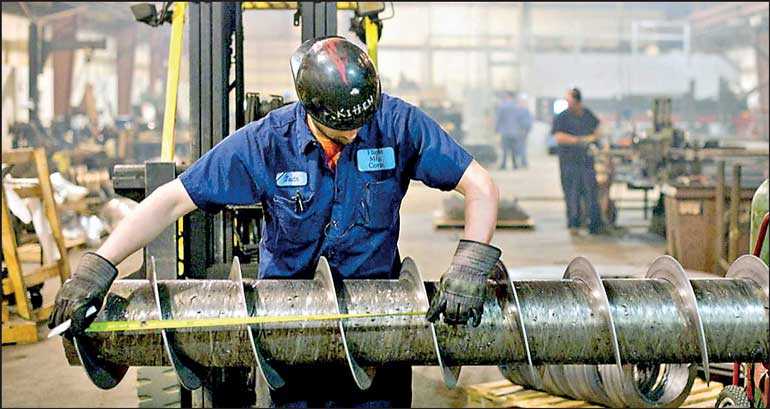Sunday Apr 20, 2025
Sunday Apr 20, 2025
Monday, 1 March 2021 00:00 - - {{hitsCtrl.values.hits}}

South Korea and Taiwan, two countries that today are regarded as manufacturing powerhouses, were agricultural economies in the 1950s. Land reforms in both countries led to rapid structural transformation in the economy, the increased productivity in agriculture that followed the reforms released workers from agriculture to manufacturing that enabled rapid export-oriented industrialisation
 Historically Sri Lanka’s economy was agrarian. Its ancient civilisation, based on rice irrigation, is one of the most celebrated along with those of Tanjore (in today’s Tamil Nadu) and Cambodia. Like much of the developing world, independent Sri Lanka’s economy was largely agricultural with export of primarily of three crops, tea, rubber and coconut.
Historically Sri Lanka’s economy was agrarian. Its ancient civilisation, based on rice irrigation, is one of the most celebrated along with those of Tanjore (in today’s Tamil Nadu) and Cambodia. Like much of the developing world, independent Sri Lanka’s economy was largely agricultural with export of primarily of three crops, tea, rubber and coconut.
With economic growth, countries typically move from primary products such agriculture into manufacturing and services. This is termed as a structural transformation of an economy. It is not that agricultural output shrinks, but other activities manufacturing and services start to play a larger role.
South Korea and Taiwan, two countries that today are regarded as manufacturing powerhouses, were agricultural economies in the 1950s. Land reforms in both countries led to rapid structural transformation in the economy, the increased productivity in agriculture that followed the reforms released workers from agriculture to manufacturing that enabled rapid export-oriented industrialisation.
The transformation of these economies took place in highly conducive policy and institutional environments, most critically the openness of these economies to the external world, labour market flexibility and macro-economic stability.
Their openness allowed these economies to tap into the virtually unlimited international trading opportunities in the world economy rather than limiting themselves to the domestic market, while foreign investment brought access to overseas markets, new production techniques, quality control and technology.
Need for right institutional framework
It is important to bear in mind that the right institutional framework is vital to kick-start a solid manufacturing base. Although Sri Lanka’s economy has undergone some structural change, since the 1960s growth has slowed, which is inevitable when reaching middle-income status.
This is because underdeveloped countries can grow simply by bringing underutilised land, labour and other inputs into productive use. By the time countries reach middle income status, the available resources tend to be fully utilised so further growth can only come from increased productivity—increasing the quantity or value of output from the available resources. This can come from not only technology but also from better business processes, upgrading skills and moving into higher productivity activities.
Encouraging high productivity in manufacturing exports is one way to achieve this. An export focus is important because it allows an escape from the limitation in size imposed by the domestic economy, thus enabling the achievement of economies of scale.
Key weaknesses that need immediate attention
Sri Lanka’s exports have a weakness in being heavily concentrated as a few markets and a handful of products make up the export basket. The Government’s National Export Strategy (NES) identifies a number of sectors including electronics and electrical components, processed foods and boatbuilding as areas where we can grow.
Electronics is a particularly attractive sector since it has the potential for creating high paying, highly skilled jobs. Global trends of digitisation, automation, miniaturisation and affordability are likely to ensure steady growth in the medium term.
Sri Lanka started as a basic assembler of consumer electronics and products in early 1970s and migrated towards electronic components and assemblies in post 1977s. Currently the industry caters to automobile, telecommunication, consumer electronics and bio-medical sectors and has attracted investments from Japan, Sweden, Switzerland, India, United Kingdom and Germany.
The question is why Sri Lanka’s 1980s apparel boom was not replicated in other manufacturing sectors. Initially, it was killed in infancy due to Black July in 1983 when the electronics plants being built in Katunayake by Motorola and Harris Corporation were relocated to Penang and a wave of Japanese investment that was about to begin was lost. That set the country back a decade but why did it not return later?
There are several barriers that are holding back FDI especially in new industries. The NES identifies the reforms needed for this nascent sector to realise its potential. The principal ones are:
Industrial zones hold the key
Some of these are quite complex problems that take time to solve. Industrial zones are a good way to solve a number of issues within a short time span and within a limited budget.
The hard infrastructure can address issues of land, power, water and waste disposal but the zones must also facilitate approvals/clearances. For example site, building plan, environmental protection license and certificate of conformity all need separate approval, though the existing export processing zones do offer an expedited process.
Unfortunately a further gamut of paperwork must go through the normal approval processes; preliminary investment clearances, work permits/visas, tax registrations, import and export registrations, import and export licenses, rules of origin certificates, chemical materials approvals and company registrations. These need to be simplified and ideally handled at a single point.
Sri Lanka’s garment industry started in industrial zones but these are almost at full capacity and we failed to build any new free trade zones between 2002 and 2017. So the first step should be to build properly equipped zones. Joining the Information Technology Agreement of the WTO to create free trade in electronics, which will also help attract FDI to this sector.
Role of banks
Both State and private banks can play a pivotal role in financing the infrastructure. Although most of Sri Lanka’s industrial zones are run by the Board of Investment (BOI), privately run zones could be encouraged. The State banks could work in partnership with private investors or even specialised overseas zone operators, providing finance to set up zones.
Similarly, the shortage of skilled workers requires investment in training facilities, which could be provided privately or through semi-government organisations. The banks could partner with established training providers, who have an established reputation to expand its training facilities.
For privately-owned zones or training facilities, the financing arrangements could take a developmental banking approach with the State banks providing a mix of debt and equity to the project. Eventually the businesses could be listed on the Colombo Stock Exchange, providing the banks with an exit from the investment and the potential for capital gains as well as dividend income from the investments.
Once infrastructure is in place, there needs to be a concerted marketing effort to sell the country as a destination for FDI. The marketing team at the BOI and Export Development Board should be selling aggressively and in constant contact with investors and potential investors and their concerns speedily addressed.
(The writer is the General Manager/CEO of People’s Bank)
Discover Kapruka, the leading online shopping platform in Sri Lanka, where you can conveniently send Gifts and Flowers to your loved ones for any event including Valentine ’s Day. Explore a wide range of popular Shopping Categories on Kapruka, including Toys, Groceries, Electronics, Birthday Cakes, Fruits, Chocolates, Flower Bouquets, Clothing, Watches, Lingerie, Gift Sets and Jewellery. Also if you’re interested in selling with Kapruka, Partner Central by Kapruka is the best solution to start with. Moreover, through Kapruka Global Shop, you can also enjoy the convenience of purchasing products from renowned platforms like Amazon and eBay and have them delivered to Sri Lanka.
Discover Kapruka, the leading online shopping platform in Sri Lanka, where you can conveniently send Gifts and Flowers to your loved ones for any event including Valentine ’s Day. Explore a wide range of popular Shopping Categories on Kapruka, including Toys, Groceries, Electronics, Birthday Cakes, Fruits, Chocolates, Flower Bouquets, Clothing, Watches, Lingerie, Gift Sets and Jewellery. Also if you’re interested in selling with Kapruka, Partner Central by Kapruka is the best solution to start with. Moreover, through Kapruka Global Shop, you can also enjoy the convenience of purchasing products from renowned platforms like Amazon and eBay and have them delivered to Sri Lanka.